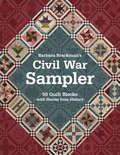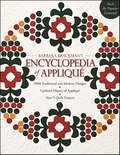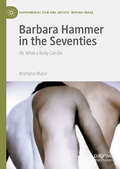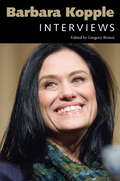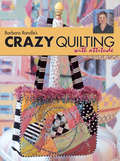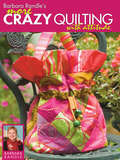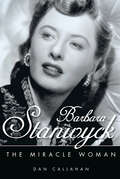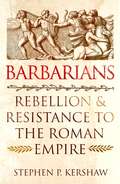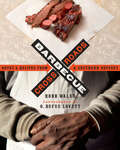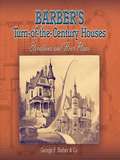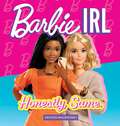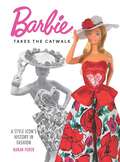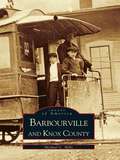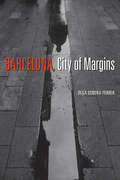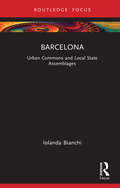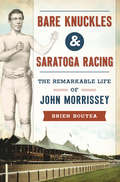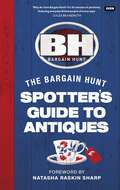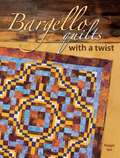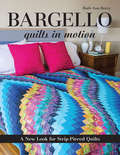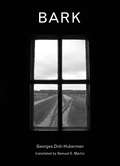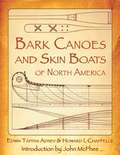- Table View
- List View
Barbara Brackman's Civil War Sampler: 50 Quilt Blocks with Stories from History
by Barbara BrackmanWitness Civil War history chronicled in quilt squares, discover more about the women behind them, and learn how to craft a quilt of your own. Journey through a historic time in American history with Barbara Brackman, bestselling author and quilt historian. Barbara's book features fifty quilt blocks that commemorate the 150th anniversary of the Civil War. Each block (most were first published in the 1930s) was selected for the symbolism its name lends to recounting stories from the era&’s women. This compilation of quilt block patterns includes period photos and first-person accounts. Choose from pieced or appliquéd blocks, each in two colorways with instructions for 8&” and 12&” sizes. Dig into your reproduction fabrics and enjoy combining blocks to make your own tribute quilt.&“This is another lovely book of Barbara&’s to add to the collection.&”—Australian Quilters Companion
Barbara Brackman's Encyclopedia Of Appliqué
by Barbara Brackmanndispensable Reference Guide for Quilt Collectors and Appliqué Lovers Put 2000 Appliqué Designs at Your Fingertips • Newly revised classic includes 2000 appliqué patterns from the 19th and 20th centuries • New in this edition: 5 appliqué quilt project and updated history of appliqué • Find the perfect block either by subject (wreaths, leaves, etc.), by type of design, or by time period • Find the name and original publication for antique applique quilts This classic compendium of appliqué blocks from quilt historian and best-selling author Barbara Brackman is back in print, and it's packed with essential information no appliqué lover should be without. *Important Note about PRINT ON DEMAND Editions: All sales are final - PODs are non-returnable and non-refundable. This title will be printed after purchase and will arrive separately from any in-stock items. Allow minimum 2 weeks for USA delivery, and additional 2 weeks for international shipments. Expedited shipping not available. Print quality will vary from the original offset-printing edition and will be printed on uncoated (non-glossy) paper. The information presented is the same as the most recent printed edition. Pattern pullouts (if applicable) have been separated and presented as single pages.
Barbara Hammer in the Seventies: Or, What a Body Can Do (Experimental Film and Artists’ Moving Image)
by Krystyna MazurBarbara Hammer in the Seventies: Or, What a Body Can Do addresses the intersection of experimental film, lesbian sexuality, and the women’s movement in Hammer’s early films. Grounded in an embodied, sexual, and gendered positionality, these films interrogate the politics of visibility and identity and perform a discontinuous repertoire of lesbian images that resist the medium of film’s established constraints and the decade’s broader systems of signification. Hammer’s films offer a critique of the dominant discourse that privileges the discreteness and self-sufficiency of the individualistic human subject. By performing the (lesbian) body in its ‘environment’—in erotic and communal relation to other bodies—and staging the relation of human bodies with the materiality of non-human beings and objects, they create a site of intervention into the humanist project, as it informs film studies, feminism, and queer theory. This rereading of Hammer’s work offers an important contribution to conversations between feminism and queer studies. In remembering the feminist origins of queer studies, it recenters political and ethical questions such as the fundamental relationality of the subject, the subject’s dependency on others, and the resulting ethical responsibility for and towards the other.
Barbara Hammer: Pushing Out of the Frame (Queer Screens)
by Sarah KellerBarbara Hammer: Pushing Out of the Frame by Sarah Keller explores the career of experimental filmmaker and visual artist Barbara Hammer. Hammer first garnered attention in the early 1970s for a series of films representing lesbian subjects and subjectivity. Over the five decades that followed, she made almost a hundred films and solidified her position as a pioneer of queer experimental cinema and art. In the first chapter, Keller covers Hammer’s late 1960s–1970s work and explores the tensions between the representation of women’s bodies and contemporary feminist theory. In the second chapter, Keller charts the filmmaker’s physical move from the Bay Area to New York City, resulting in shifts in her artistic mode. The third chapter turns to Hammer’s primarily documentary work of the 1990s and how it engages with the places she travels, the people she meets, and the histories she explores. In the fourth chapter, Keller then considers Hammer’s legacy, both through the final films of her career—which combine the methods and ideas of the earlier decades—and her efforts to solidify and shape the ways in which the work would be remembered. In the final chapter, excerpts from the author’s interviews with Hammer during the last three years of her life offer intimate perspectives and reflections on her work from the filmmaker herself. Hammer’s full body of work as a case study allows readers to see why a much broader notion of feminist production and artistic process is necessary to understand art made by women in the past half century. Hammer’s work—classically queer and politically feminist—presses at the edges of each of those notions, pushing beyond the frames that would not contain her dynamic artistic endeavors. Keller’s survey of Hammer’s work is a vital text for students and scholars of film, queer studies, and art history.
Barbara Kopple: Interviews (Conversations with Filmmakers Series)
by Gregory BrownWith a career spanning more than forty years, Barbara Kopple (b. 1946) long ago established herself as one of the most prolific and award-winning American filmmakers of her generation. Her projects have ranged from labor union documentaries to fictional feature films to an educational series for kids on the Disney Channel. Through it all, Kopple has generously made herself available for a great many print and broadcast interviews. The most revealing and illuminating of these are brought together in this collection.Here, Kopple explains her near-constant struggles to raise money (usually while her films are already in production) and the hardships arising from throwing her own money into such projects. She makes clear the tensions between biases, objectivity, and fairness in her films. Her interviewers raise fundamental questions. What is the relationship between real people in documentaries and characters in fictional films? Why does she embrace a cinéma vérité style in some films but not others? Why does she seem to support gun ownership in Harlan County, U.S.A., only to take a decidedly more neutral view of the issue in her film Gun Fight?Kopple's concern for people facing crises is undeniable. So is the affection she has for her more famous subjects--Woody Allen playing a series of European jazz concerts, Gregory Peck on tour, and the Dixie Chicks losing a fan base but making a fresh start.
Barbara Randle's Crazy Quilting With Attitude
by Barbara RandleIf you're searching for a fresh approach to the age-old art of crazy quilting, look no further than Barbara Randle's Crazy Quilting with Attitude. Here are throw pillows, lampshades, purses, scarves - lots of artsy projects your great grandmother could never have imagined! Included are chapters on traditional crazy quilting techniques, how to choose and mix colors, and some embellishment ideas that will take your creations over the top. Over 12 fun and fast crazy quilting projects to make Clear, easy step-by-step directions and abundant photographs Great tips on color combinations and glitzy, gorgeous embellishments
Barbara Randle's More Crazy Quilting with Attitude
by Barbara RandleFans of crazy quilting will happily lose themselves in the exciting world of Barbara Randle's More Crazy Quilting with Attitude. In this follow-up to Randle's wildly popular Barbara Randle's Crazy Quilting with Attitude, quilters learn three trendy techniques for crazy quilting and embellishing, along with tips for designing their own handbags. Featured in this ultimate crazy-quilting reference are 14 projects, including a throw, diaper bag and a variety of handbags plus a gallery with tips for customizing clothing and home decor. Quilting enthusiasts of all skill levels will benefit from Randle's easy-to-follow instructions, demonstrated in more than 60 illustrations and 100+ stunning color photos. Plus, full-size patterns for two handbag projects are included with this must-have resource!
Barbara Stanwyck: The Miracle Woman (Hollywood Legends Series)
by Dan CallahanBarbara Stanwyck (1907–1990) rose from the ranks of chorus girl to become one of Hollywood's most talented leading women—and America's highest-paid woman in the mid-1940s. Shuttled among foster homes as a child, she took a number of low-wage jobs while she determinedly made the connections that landed her in successful Broadway productions. Stanwyck then acted in a stream of high-quality films from the 1930s through the 1950s. Directors such as Cecil B. DeMille, Fritz Lang, and Frank Capra treasured her particular magic. A four-time Academy Award nominee, winner of three Emmys and a Golden Globe, she was honored with a Lifetime Achievement Award by the Academy. Dan Callahan considers both Stanwyck's life and her art, exploring her seminal collaborations with Capra in such great films as Ladies of Leisure, The Miracle Woman, and The Bitter Tea of General Yen; her Pre-Code movies Night Nurse and Baby Face; and her classic roles in Stella Dallas, Remember the Night, The Lady Eve, and Double Indemnity. After making more than eighty films in Hollywood, she revived her career by turning to television, where her role in the 1960s series The Big Valley renewed her immense popularity. Callahan examines Stanwyck's career in relation to the directors she worked with and the genres she worked in, leading up to her late-career triumphs in two films directed by Douglas Sirk, All I Desire and There's Always Tomorrow, and two outrageous westerns, The Furies and Forty Guns. The book positions Stanwyck where she belongs—at the very top of her profession—and offers a close, sympathetic reading of her performances in all their range and complexity.
Barbarians: Rebellion and Resistance to the Roman Empire
by Dr Stephen P. KershawA fresh new look at the Roman Empire, from the point of view of those regarded by the Romans as 'barbarians'. Kershaw builds a narrative around the lives, personalities, successes and failures both of the key opponents of Rome's rise and dominance, and of the those who ultimately brought the empire down.'And now what will become of us without barbarians?Those people were a sort of solution.' 'Waiting for the Barbarians' C. P. CavafyHistory is written by the victors, and Rome had some very eloquent historians. Those the Romans regarded as barbarians left few records of their own, but they had a tremendous impact on the Roman imagination. Resisting from outside Rome's borders or rebelling from within, they emerge vividly in Rome's historical tradition, and left a significant footprint in archaeology.Rome's history, as written by the Romans, follows a remarkable trajectory from its origins as a tiny village of refugees from a conflict zone to a dominant superpower, before being transformed into the medieval and Byzantine worlds. But throughout this history, Rome faced significant resistance and rebellion from peoples whom it regarded as barbarians. Gibbon saw the Roman Empire as one of the highest points of human achievement destroyed by barbarian invaders: Ostrogoths, Visigoths, Goths, Vandals, Huns, Picts and Scots. To others, as Rome was ravaged, new life was infused into an expiring Italy. Gibbon's 'decline and fall' has been reappraised as transformation, through religious and cultural revolution. Based both on ancient historical writings and modern archaeological research, this new history takes a fresh look at the Roman Empire, through the personalities and lives of key opponents of Rome's rise, dominance and fall - or transformation. These include: Brennus, the Gaul who sacked Rome; the Plebs, those barbarous insiders and internal resistors; Hannibal; Viriathus, the Iberian shepherd and skilled guerilla; Jugurtha and the struggle to free Africa; the Germanic threat from the Cimbri and the Teutones; Spartacus, the gladiator; Vercingetorix and rebellion in Gaul; Cleopatra; Boudicca, the Queen of the Iceni and the scourge of Rome; the Great Jewish Revolt; Alaric the Goth and the Sack of Rome; Attila the Hun, 'Born to Shake the Nations'; and the Vandals and the fall of Rome.
Barbecue Crossroads: Notes & Recipes from a Southern Odyssey
by Robb WalshIn stories, recipes, and photographs, James Beard Award–winning writer Robb Walsh and acclaimed documentary photographer O. Rufus Lovett take us on a barbecue odyssey from East Texas to the Carolinas and back. In Barbecue Crossroads, we meet the pitmasters who still use old-fashioned wood-fired pits, and we sample some of their succulent pork shoulders, whole hogs, savory beef, sausage, mutton, and even some barbecued baloney. Recipes for these and the side dishes, sauces, and desserts that come with them are painstakingly recorded and tested. But Barbecue Crossroads is more than a cookbook; it is a trip back to the roots of our oldest artisan food tradition and a look at how Southern culture is changing. Walsh and Lovett trace the lineage of Southern barbecue backwards through time as they travel across a part of the country where slow-cooked meat has long been part of everyday life. What they find is not one story, but many. They visit legendary joints that don’t live up to their reputations—and discover unknown places that deserve more attention. They tell us why the corporatizing of agriculture is making it difficult for pitmasters to afford hickory wood or find whole hogs that fit on a pit. Walsh and Lovett also remind us of myriad ways that race weaves in and out of the barbecue story, from African American cooking techniques and recipes to the tastes of migrant farmworkers who ate their barbecue in meat markets, gas stations, and convenience stores because they weren’t welcome in restaurants. The authors also expose the ways that barbecue competitions and TV shows are undermining traditional barbecue culture. And they predict that the revival of the community barbecue tradition may well be its salvation.
Barbecue Crossroads: Notes & Recipes from a Southern Odyssey
by Robb WalshIn stories, recipes, and photographs, James Beard Award–winning writer Robb Walsh and acclaimed documentary photographer O. Rufus Lovett take us on a barbecue odyssey from East Texas to the Carolinas and back. In Barbecue Crossroads, we meet the pitmasters who still use old-fashioned wood-fired pits, and we sample some of their succulent pork shoulders, whole hogs, savory beef, sausage, mutton, and even some barbecued baloney. Recipes for these and the side dishes, sauces, and desserts that come with them are painstakingly recorded and tested. But Barbecue Crossroads is more than a cookbook; it is a trip back to the roots of our oldest artisan food tradition and a look at how Southern culture is changing. Walsh and Lovett trace the lineage of Southern barbecue backwards through time as they travel across a part of the country where slow-cooked meat has long been part of everyday life. What they find is not one story, but many. They visit legendary joints that don’t live up to their reputations—and discover unknown places that deserve more attention. They tell us why the corporatizing of agriculture is making it difficult for pitmasters to afford hickory wood or find whole hogs that fit on a pit. Walsh and Lovett also remind us of myriad ways that race weaves in and out of the barbecue story, from African American cooking techniques and recipes to the tastes of migrant farmworkers who ate their barbecue in meat markets, gas stations, and convenience stores because they weren’t welcome in restaurants. The authors also expose the ways that barbecue competitions and TV shows are undermining traditional barbecue culture. And they predict that the revival of the community barbecue tradition may well be its salvation.
Barber's Turn-of-the-Century Houses: Elevations and Floor Plans (Dover Architecture)
by George F. BarberAt the turn of the twentieth century, George F. Barber ran a successful architectural firm. Today, surviving examples of Barber's signature designs are the pride of their communities. This architectural snapshot from 1901 features working floor plans and fine drawings of more than eighty of Barber's distinctive dwellings.Specializing in serving a mail-order clientele, Barber's company produced catalogs "giving floor plans of a convenient and practical character, and exterior designs of artistic merit in the various prevailing styles." Prepared from long, practical experience, the handsome designs and plans range from the modest to the magnificent, including stately Georgians and colonials as well as snug country homes and seaside cottages. Loaded with spacious kitchens and double parlors as well as porches and balconies of beautiful classic design, this authentic guide will fascinate architectural historians, preservationists, and home restorers, along with anyone interested in Victorian-era architecture.
Barbie IRL (In Real Life): Honestly, Same.
by Kristen MulrooneyBarbie has never been more relatable than in this officially licensed laugh-out-loud book that pairs real-world thoughts with images from the mega-popular @barbiestyle Instagram.&“And then he said it&’s just a dog&’s birthday party.&”&“Dump him.&” Barbie isn&’t perfect—far from it. Honestly, she&’s just like us. Barbie has bad hair days. She's late to work (that oat latte had nothing to do with it). Nothing is fitting right. She&’s also thinking about brunch after yoga. And she&’s definitely so over having her job explained to her. Yet, Barbie can still find empowerment and strength through it all. For fans of books like Men to Avoid in Art and Life, Barbie IRL (In Real Life) pairs real-world thoughts and everyday problems with images from the popular and fashionable @barbiestyle Instagram. Beneath perfect Instagram posts and highlight reels, we all have our own insecurities and issues—and this hilarious take on Barbie by humorist Kristen Mulrooney is a much-needed reminder that even the most flawlessly presenting dolls have issues of their own. A perfect gift for any Barbie lover or fan of the Barbie film, this book is presented in a perfect pink package, and filled with over 70 images and captions, in addition to 10 tips from Barbie about confidence, workplace, style, travel, and more.
Barbie Takes the Catwalk: A Style Icon's History in Fashion
by Karan FederBarbie has always been a fashion icon, with a wardrobe of looks inspired by the world&’s great fashion designers, and inspiring them as well with her signature style. From decade-defining designs by formidable fashion royalty such as Dior, Balenciaga, Yves St. Laurent, Pucci, and Chanel, to skateboard culture and rave fashion, Barbie doll&’s outfits have reflected the fashion and the time. In Barbie Takes the Catwalk, hundreds of images from designer runways, magazine editorials, and fashion archives are paired with detailed photographs of vintage Barbie outfits to offer an unprecedented examination of the Barbie brand&’s sartorial impact. Author and costume historian Karan Feder thoughtfully explores Barbie doll's first 40 years to highlight the vast artistry and cultural significance of the doll&’s fashion canon, and looks at contemporary fashion designers influenced by the Barbie legacy. This meticulously researched and gorgeous book is a must for any fan of fashion, pop culture, and Barbie. MORE THAN 100 FASHION PHOTOS: Hundreds of photos from the runways of designers that have influenced Barbie, including André Courrèges, Bill Gibb, Christian Lacroix, Emanuel Ungaro, Karl Lagerfeld, and Thierry Mugler. 125 ICONIC BARBIE LOOKS: From &“Enchanted Evening&” to the totally-80s looks of Barbie and the Rockers, Barbie Takes the Catwalk offers a stunning retrospective of the doll&’s fashion canon. INFLUENCE AND IMPACT: Explores the relationship between the world&’s great fashion houses and the world&’s best-selling and most-loved fashion doll. AWARD-WINNING AUTHOR: Karan Feder is an award-winning costume designer, historian, and the curator of the traveling exhibition of Barbie&’s fashion history, called Barbie®, A Cultural Icon: 60 Years of Fashion and Inspiration. THE PERFECT GIFT for fans of art, fashion, design, or Barbie, Barbie Takes the Catwalk is a fascinating historical record of the fashionable trends and popular-cultural themes inherent within Barbie&’s vast clothes closet.
Barbie: 50 Dreamy Recipes for Inspired Entertaining
by Ginny LandtCocktail and Barbie lovers rejoice—Barbie: The Official Cocktail Book is here! The cocktails, mocktails, and drinks featured in this book, alongside bright drink photography, inspired by all things Barbie, is perfect for fans of the pink icon, and ideal for gatherings, celebrations, and everyday entertaining. Barbie knows how to celebrate moments, big and small. With this officially licensed recipe book, you can make yourself and your friends delicious drinks to accompany all of your accomplishments. This book is filled with cocktails and mocktails inspired by the one and only Barbie, her iconic looks throughout the years, her signature color, and every corner of her world. Take a look at: The Day-to-Night Refresher, inspired by the unforgettable 1985 Day-to-Night Barbie. Or maybe you&’ve got your eye on the Beachy Mojito, inspired by the Malibu Beach Café pop-up experience. Possibly you&’re feeling adventurous and want a classic cocktail but with a Barbie twist, such as the French 59, honoring the debut year of Barbie. And many more! Barbie: The Official Cocktail Book is features dozens of easy-to-make, delightful recipes alongside beautiful photographs. This bright collection of delicious drinks is sure to delight Barbie lovers everywhere.
Barbourville and Knox County
by Michael C. MillsKnox County was created in 1799, and the town of Barbourville sprang up on the banks of the Cumberland River, at the mouth of Richland Creek. The site of one of the first small battles of the Civil War, Barbourville grew from a sleepy little community into a center of trade and travel in Kentucky. Both the town and the county are celebrated and explored in this unique collection, one that showcases the pioneering spirit and achievements of the area's earliest settlers. History was made in Knox County even before the county was formed, as Daniel Boone blazed the trails known as the Wilderness Road; his legacy left an indelible mark on the community, present today in its most popular tourist attractions and annual festivals. Just as Boone altered the course of the county's history, so too did the advent of coal mining, the discovery of gas, the coming of the railroad, the devastation of floods, and the development of schools. These and many other fascinating elements of Knox County's heritage are brought to life in photographs culled from the collections of the Cumberland Gap Historical Park, The Knox County Historical Museum, The Filson Club, The Kentucky Historical Society, and numerous private collections.
Barcelona, City of Margins (Toronto Iberic)
by Olga Sendra FerrerBarcelona, City of Margins studies the creation of a space of dissent in the 1950s and 1960s that became the pillar of the protest movements during the final years of the Franco dictatorship and the transition to democracy. This space of dissent took shape in the margins of what is considered the official space of the city of Barcelona, revealing the interconnection of urbanism, literature, and photography in the formation of the political, social, and cultural movements to come in the 1970s. Olga Sendra Ferrer draws from theoretical readings on built environments, neighbourhoods, housing projects and developments, and everyday life within Spanish urban spaces. Literature and photography demonstrate the political value of cultural production and forms of cultural representation that occur from peripheral zones – those pushed aside by exclusionary politics, fascist forms of control, surveillance, and homogenization. In search of the origins of the protest movements and counter culture that would come in the final years of the Franco regime, Barcelona, City of Margins asserts the value of urban movement and cultural practice as a challenge to the spatial and urbanistic regime of Francoism.
Barcelona: Urban Commons and Local State Assemblages (Built Environment City Studies)
by Iolanda BianchiThis book explores the complex relationship between urban commons – understood as a repertoire of collective action that fosters a politics of antagonism – and the local state. It critiques the dominant neo-institutionalist and neo-Marxist perspectives for their deterministic and siloed views, as well as the insufficient attention they pay to the municipal scale. The book proposes a more nuanced, urban-based, outcome-oriented approach rooted in assemblage theory.The analysis addresses a central question: can urban commons-local state assemblages benefit the politics of urban commons? The book argues that they can, provided they form rhizomatic assemblages. These allow urban commons to retain their self-governing autonomy, even as they lose some of their material autonomy. Conversely, it shows that assemblages can also take arborescent forms, allowing the local state to undermine the self-governing autonomy of the urban commons.Focusing on Barcelona, the book examines how rhizomatic and arborescent assemblages are constructed, as well as the strategies that urban commons can undertake to build rhizomatic assemblages. This book is essential for scholars, policymakers, and activists interested in urban governance, commons theory and transformative politics. It provides both theoretical insights and practical tools for harnessing the dynamics of the urban commons and the local state to drive meaningful socio-political change.
Bare Knuckles & Saratoga Racing: The Remarkable Life of John Morrissey (Sports)
by Brien BouyeaOne of the more dynamic characters of his time, John "Old Smoke" Morrissey made his way from undefeated bare-knuckle boxer to found the Saratoga Race Course and win elections to Congress and the New York State Senate. A poor, uneducated Irish immigrant, Morrissey became a leader in the Dead Rabbits street gang. He won fame as a fighter and fortune as the operator of a string of successful gambling houses. He then took Saratoga Springs by storm. He improbably resurrected thoroughbred racing during the Civil War and opened his famous Club House, the most glamorous casino the country had ever seen. Author Brien Bouyea chronicles the incomparable life of a true American legend.
Barefoot Study Guide (Sensible Shoes Series)
by Sharon Garlough BrownThe journeys of Hannah, Meg, Charissa, and Mara take unexpected turns in Barefoot, the third book of the Sensible Shoes series. In this study guide author Sharon Garlough Brown has crafted a practical resource to help you process the characters' stories and explore the novel's spiritual formation themes more deeply. You'll find twelve weeks of daily Scripture readings, reflection questions, and invitations to prayer, with weekly discussion questions and practices for groups to do together. Each week also features a list of spiritual disciplines used by the characters that you can incorporate into your own life with God. Individually or with a group, as you walk with the women of Sensible Shoes on holy ground, you'll be invited to encounter God in significant new ways.
Bargain Hunt: The Spotter's Guide to Antiques
by Karen FarringtonBargain Hunt is a British institution, entertaining audiences for over 20 years, and encouraging us to look for diamonds in the rough at antique fairs and shops across the country. A Bargain Hunt is more than just a quest for cash, though - from traveller's trunks and tea caddies to walking canes, coins and quirky costumes, each of the items chosen has their own story to tell, forming a small part of our collective social history.The Bargain Hunt Spotter's Guide to Antiques is packed with essential information from the Bargain Hunt experts on identifying quality across a range of antiques. From makers' marks and tell-tale historical styles to details in foils and finials, this will be your one-stop guide to making good choices on your own bargain hunt - while also delving into the fascinating stories behind many of our favourite antiques.With a foreword from Natasha Raskin Sharp, as well as tips, advice, and stories throughout from each of the show's experts (including 'league tables' of best and worst finds), this is the essential companion to all your future Bargain Hunts!
Bargello Quilts with a Twist
by Maggie BallIf you love traditional Bargello quilts with their illusion of curves and flowing waves, but are wary of tedious cutting and the complexity of creating free-form patterns, this new 16-piece Bargello block technique allows you to have fun playing with a collection of blocks to create endless possibilities - the more blocks and colors, the more possibilities. With the newly created block method,Bargello Quilts with a Twistallows you to create the look of Bargello with ease. Strips are cut and pieced in sets of four, counter-cut, and joined to complete the blocks. Using the versatile pattern, there are an amazing number of ways to arrange as few as 16 blocks to create exciting and unique patterns.
Bargello: A New Look for Strip-Pieced Quilts
by Ruth Ann BerryCreate stunning quilts with flowing curves with this 8-project guide by a designer who offers a fresh take on bargello quilting techniques. Here's Bargello like you've never seen it before: stunning quilts full of free-form twists, turns, and 3-D effects that look like pop-art paintings. The biggest surprise is how simple these quilts are to make! Designer Ruth Ann Berry shows you how to use easy, straight-line strip piecing to create the illusion of curves in motion. This volume includes step-by-step instructions for 8 projects plus directions on how to create your own designs. Perfect for daily use quilts or wallhangings, Bargello piecing also provides a new way to slice up your stash―making novelty fabrics and even ugly fabrics look good.
Bark (The\mit Press Ser.)
by Georges Didi-HubermanA noted French thinker's poignant reflections, in words and photographs, on his visit to Auschwitz-Birkenau.On a visit to Auschwitz-Birkenau, Georges Didi-Huberman tears three pieces of bark from birch trees on the edge of the site. Looking at these pieces after his return home, he sees them as letters, a flood, a path, time, memory, flesh. The bark serves as a springboard to Didi-Huberman's meditations on his visit, recorded in this spare, poetic, and powerful book. Bark is a personal account, drawing not on the theoretical apparatus of scholarship but on Didi-Huberman's own history, memory, and knowledge. The text proceeds as a series of reflections, accompanied by Didi-Huberman's photographs of the visit. The photographs are not meant to be art—Didi-Huberman confesses that he “photographed practically everything without looking”—but approach it nevertheless. Didi-Huberman tells us that his grandparents died at Auschwitz, but his account is more universal than biographical. As he walks from place to place, he observes that in German birches are birken; Birkenau designates the meadow where the birches grow. Didi-Huberman sees and photographs the “reconstructed” execution wall; the floors of the crematorium, forgotten witnesses to killing; and the birch trees, lovely but also resembling prison bars. Taking his own photographs, he thinks of the famous photographs taken in 1944 by a member of the Sonderkommando, the only photographic documentation of the camp before the Germans destroyed it, hoping to hide the evidence of their crimes. Didi-Huberman notices a “bizarre proliferation of white flowers on the exact spot of the cremation pits.” The dead are not departed.
Bark Canoes and Skin Boats of North America
by Howard I. Chapelle Edwin Tappan Adney John McPheeThe bark canoes of the North American Indians, particularly those of birchbark, were among the most highly developed manually propelled primitive watercraft. Built with Stone Age tools from available materials, their design, size, and appearance were varied to suit the many requirements of their users. Even today, canoes are based on these ancient designs, and this fascinating guide combines historical background with instructions for constructing one. Author Edwin Tappan Adney, born in 1868, devoted his life to studying canoes and was practically the sole scholar in his field. His papers and research have been assembled by a curator at the Smithsonian Institution.
